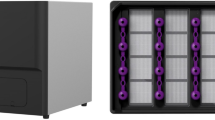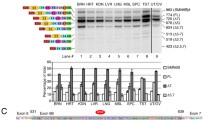Abstract
Spinal muscular atrophy (SMA) is an autosomal recessive disease caused by mutation or deletion of the survival motor neuron gene 1 (SMN1). The highly homologous gene, SMN2, is present in all patients, but it cannot compensate for loss of SMN1. SMN2 differs from SMN1 by a few nucleotide changes, but a C → T transition in exon 7 leads to exon skipping. As a result, most transcripts from the SMN2 gene lack exon 7. Although SMN1 is the disease-determining gene, the number of SMN2 copies appears to modulate SMA clinical phenotypes. Thus, determining the SMN copy number is important for clinical diagnosis and prognosis. We have developed a quantitative real-time TaqMan polymerase chain reaction assay for both the SMN1 and SMN2 genes, in which reliable copy number determination was possible on deoxyribonucleic acid samples obtained by two different isolation methods and from two different sources (human blood and skin fibroblasts). For SMN1, allele specificity was attained solely by addition of an allele-specific forward primer and, for SMN2, by addition of a specific forward primer and a nonextending oligonucleotide (SMN1 blocker) that reduced nonspecific amplification from SMN1 to a negligible level. We validated the reliability of this real-time polymerase chain reaction approach and found that the coefficient of variation for all the gene copy number measurements was below 10%. Quantitative analysis of the SMN copy number in SMA fibroblasts by this approach showed deletion of SMN1 and an inverse correlation between the SMN2 copy number and severity of the disease..


Similar content being viewed by others
References
Emery AE (1991) Population frequencies of inherited neuromuscular diseases—a world survey. Neuromuscul Disord 1:19–29
Pearn JH (1973) The gene frequency of acute Werdnig–Hoffmann disease (SMA type 1). A total population survey in North-East England. J Med Genet 10:260–265
Pearn J (1978) Incidence, prevalence, and gene frequency studies of chronic childhood spinal muscular atrophy. J Med Genet 15:409–413
Ogino S, Leonard DG, Rennert H, Ewens WJ, Wilson RB (2002) Genetic risk assessment in carrier testing for spinal muscular atrophy. Am J Med Genet 110:301–307
Munsat TL, Davies KE (1992) International SMA consortium meeting. Neuromuscul Disord 2:423–428
Lefebvre S, Burglen L, Reboullet S, Clermont O, Burlet P, Viollet L, Benichou B, Cruaud C, Millasseau P, Zeviani M et al (1995) Identification and characterization of a spinal muscular atrophy-determining gene. Cell 80:155–165
Cartegni L, Krainer AR (2002) Related articles, disruption of an SF2/ASF-dependent exonic splicing enhancer in SMN2 causes spinal muscular atrophy in the absence of SMN1. Nat Genet 30:377–384
Lorson CL, Hahnen E, Androphy EJ, Wirth B (1999) Related articles, a single nucleotide in the SMN gene regulates splicing and is responsible for spinal muscular atrophy. Proc Natl Acad Sci USA 96:6307–6311
Wirth B, Herz M, Wetter A, Moskau S, Hahnen E, Rudnik-Schoneborn S, Wienker T, Zerres K (1999) Quantitative analysis of survival motor neuron copies: identification of subtle SMN1 mutations in patients with spinal muscular atrophy, genotype–phenotype correlation, and implications for genetic counseling. Am J Hum Genet 64:1340–1356
Burghes AH (1997) When is a deletion not a deletion? When it is converted. Am J Hum Genet 61:9–15
Lefebvre S, Burlet P, Liu Q, Bertrandy S, Clermont O, Munnich A, Dreyfuss G, Melki J (1997) Correlation between severity and SMN protein level in spinal muscular atrophy. Nat Genet 16:265–269
Feldkotter M, Schwarzer V, Wirth R, Wienker TF, Wirth B (2002) Quantitative analyses of SMN1 and SMN2 based on real-time lightCycler PCR: fast and highly reliable carrier testing and prediction of severity of spinal muscular atrophy. Am J Hum Genet 70:358–368
Wirth B, Brichta L, Schrank B, Lochmuller H, Blick S, Baasner A, Heller R (2006) Mildly affected patients with spinal muscular atrophy are partially protected by an increased SMN2 copy number. Hum Genet 119:422–428
Monani UR, Sendtner M et al (2000) The human centromeric survival motor neuron gene (SMN2) rescues embryonic lethality in Smn(−/−) mice and results in a mouse with spinal muscular atrophy. Hum Mol Genet 9:333–339
Chang JG, Hsieh-Li HM, Jong YJ, Wang NM, Tsai CH, Li H (2001) Treatment of spinal muscular atrophy by sodium butyrate. Proc Natl Acad Sci USA 98:9808–9813
Andreassi C, Jarecki J, Zhou J, Coovert DD, Monani UR, Chen X, Whitney M, Pollok B, Zhang M, Androphy E, Burghes AH (2001) Aclarubicin treatment restores SMN levels to cells derived from type I spinal muscular atrophy patients. Hum Mol Genet 10:2841–2849
Sumner CJ, Huynh TN, Markowitz JA, Perhac JS, Hill B, Coovert DD, Schussler K, Chen X, Jarecki J, Burghes AH, Taylor JP, Fischbeck KH (2003) Valproic acid increases SMN levels in spinal muscular atrophy patient cells. Ann Neurol 54:647–654
Brichta L, Hofmann Y, Hahnen E, Siebzehnrubl FA, Raschke H, Blumcke I, Eyupoglu IY, Wirth B (2003) Valproic acid increases the SMN2 protein level: a well-known drug as a potential therapy for spinal muscular atrophy. Hum Mol Genet 12:2481–2489
van der Steege G, Grootscholten PM, van der Vlies P, Draaijers TG, Osinga J, Cobben JM, Scheffer H, Buys CH (1995) PCR-based DNA test to confirm clinical diagnosis of autosomal recessive spinal muscular atrophy. Lancet 345:985–986
Chan V, Yip B, Yam I, Au P, Lin CK, Wong V, Chan TK (2004) Carrier incidence for spinal muscular atrophy in southern Chinese. J Neurol 251:1089–1093
Anhuf D, Eggermann T, Rudnik-Schoneborn S, Zerres K (2003) Determination of SMN1 and SMN2 copy number using TaqMan technology. Human Mutat 22:74–78
Pyatt RE, Prior TW (2006) A feasibility study for the newborn screening of spinal muscular atrophy. Genet Med 8:428–437
Lee TM, Kim SW, Lee KS, Jin HS, Koo SK, Jo I, Kang S, Jung SC (2004) Quantitative analysis of SMN1 gene and estimation of SMN1 deletion carrier frequency in Korean population based on real-time PCR. J Korean Med Sci 19:870–873
Wang W, Dimatteo D et al (2005) Increased susceptibility of spinal muscular atrophy fibroblasts to camptothecin-induced cell death. Mol Genet Metab 85:38–45
Mimault C, Giraud G, Courtois V, Cailloux F, Boire JY, Dastugue B, Boespflug-Tanguy O (1999) Proteolipoprotein gene analysis in 82 patients with sporadic Pelizaeus–Merzbacher Disease: duplications, the major cause of the disease, originate more frequently in male germ cells, but point mutations do not. Am J Hum Genet 65:360–369
Livak KJ, Schmittgen TD (2001) Analysis of relative gene expression data using real-time quantitative PCR and the 2(-Delta Delta C(T)) Method. Methods 25:402–408
Coovert DD, Le TT et al (1997) The survival motor neuron protein in spinal muscular atrophy. Hum Mol Genet 6:1205–1214
Martin Y, Valero A, Castillo E, Pascual SI, Hernandez-Chico C (2002) Genetic study of SMA patients without homozygous SMN1 deletions: identification of compound heterozygotes and characterisation of novel intragenic SMN1 mutations. Hum Genet 110:257–263
Sun Y, Grimmler M, Schwarzer V, Schoenen F, Fischer U, Wirth B (2005) Molecular and functional analysis of intragenic SMN1 mutations in patients with spinal muscular atrophy. Human Mutat 25:64–71
Wirth B (2000) An update of the mutation spectrum of the survival motor neuron gene (SMN1) in autosomal recessive spinal muscular atrophy (SMA). Human Mutat 15:228–237
Celi FS, Cohen MM, Antonarakis SE, Wertheimer E, Roth J, Shuldiner AR (1994) Determination of gene dosage by a quantitative adaptation of the polymerase chain reaction (gd-PCR): rapid detection of deletions and duplications of gene sequences. Genomics 21:304–310
Ogino S, Leonard DG, Rennert H, Gao S, Wilson RB (2001) Heteroduplex formation in SMN gene dosage analysis. J Mol Diagnostics 3:150–157
McAndrew PE, Parsons DW, Simard LR, Rochette C, Ray PN, Mendell JR, Prior TW, Burghes AH (1997) Identification of proximal spinal muscular atrophy carriers and patients by analysis of SMNT and SMNC gene copy number. Am J Hum Genet 60:1411–1422
Gerard B, Ginet N, Matthijs G, Evrard P, Baumann C, Da Silva F, Gerard-Blanluet M, Mayer M, Grandchamp B, Elion J (2000) Genotype determination at the survival motor neuron locus in a normal population and SMA carriers using competitive PCR and primer extension. Human Mutat 16:253–263
Ogino S, Wilson RB (2002) Quantification of PCR bias caused by a single nucleotide polymorphism in SMN gene dosage analysis. J Mol Diagnostics 4:185–190
Ogino S, Wilson RB (2002) Genetic testing and risk assessment for spinal muscular atrophy (SMA). Hum Genet 111:477–500
Acknowledgments
We thank Dr. Brunhilde Wirth for the externally validated DNA standards, Priscilla Moses for help with cell cultures, and Drs. Robert Mason, Andre Salama, and Jeffery Twiss for critical comments on this work. Some patient cell lines were provided by a MRDD research center grant, HD024061, at Johns Hopkins University. This work was supported by Nemours and a COBRE grant award from the NIH (1 P20 RR020173-01) to support the Center for Pediatric Research at the Alfred I. duPont Hospital for Children.
Author information
Authors and Affiliations
Corresponding author
Additional information
An erratum to this article can be found at http://dx.doi.org/10.1007/s10048-009-0181-5
Rights and permissions
About this article
Cite this article
Gómez-Curet, I., Robinson, K.G., Funanage, V.L. et al. Robust quantification of the SMN gene copy number by real-time TaqMan PCR. Neurogenetics 8, 271–278 (2007). https://doi.org/10.1007/s10048-007-0093-1
Received:
Accepted:
Published:
Issue Date:
DOI: https://doi.org/10.1007/s10048-007-0093-1




